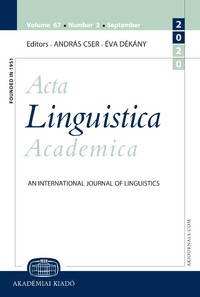Deriving Level 1/Level 2 affix classes in English: Floating vowels, cyclic syntax
Deriving Level 1/Level 2 affix classes in English: Floating vowels, cyclic syntax
Author(s): Heather NewellSubject(s): Morphology
Published by: Akadémiai Kiadó
Keywords: Level 1/Level 2 affixes; CVCV Phonology; floating segments; liaison; Distributed Morphology; stress; phases; modularity
Summary/Abstract: This article accounts for the traditionally-labelled Level 1/Level 2 affix distinction in English by combining the predictions of floating segmental structure (e.g. Rubach 1996) and cyclic spell-out by phase (Chomsky 1999; Marantz 2007). It offers insight not only into the different phonological patterns these affixes trigger, but importantly, explains when the same affix will trigger distinct phonological patterns (when an affix behaves sometimes as Level 1 and sometimes as Level 2). It is argued that Level 1 affixes are distinguished by an initial floating vowel in their underlying representations, and that if we combine this with the proposal that affixes that merge directly to roots are interpreted in the same phonological cycle as these roots then we can remove the reference to diacritic notions such as Level 1 and Level 2 from the grammar. This then allows for a fully modular account of English affix classes, where the phonological derivation refers solely to phonological representations.
- Issue Year: 68/2021
- Issue No: 1-2
- Page Range: 31-76
- Page Count: 46
- Language: English
- Content File-PDF

